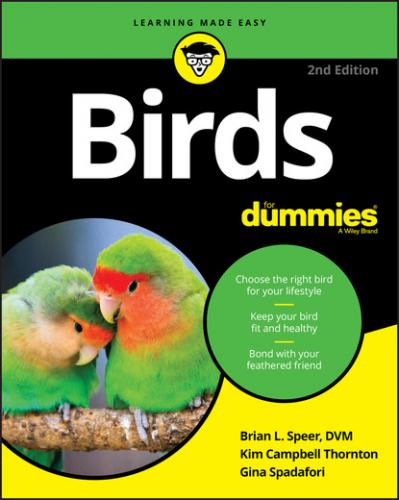Photograph courtesy of D. Davidson Harpur
FIGURE 2-8: Spicoli, who resembles the avian version of a Dalmatian, is a silver-spangled Hamburg.
Chickens have been domesticated for more than 7,000 years, but only recently have they become widely popular as pets. Some people keep exotic and heritage breeds of chickens for their beautiful or unusual appearance (the Appenzeller Spitzhauben is described as resembling a Dalmatian with a mohawk), while others consider such factors as temperament, adaptability to cold or hot weather, small size (the better to keep one in a condo), and laying ability.
Prices can range from $5 for a day-old unsexed (meaning you may get a rooster) buff Orpington chick to $99 for a day-old unsexed Deathlayer chick, known for a luxuriant tail and black feathers glistening with iridescent green and purple. Chickens are social, so you’ll want to have two or more. Don’t forget to factor in the cost of a coop, nest boxes, and other equipment.
Like chickens, ducks come in some striking varieties and can provide you with delicious fresh eggs! Geese can be outstanding watch-birds, and even turkeys can be beautiful and affectionate. Peafowl, the males at least, are gorgeous, but the loud screams of the males are not for everyone and may not contribute to good relationships with your neighbors.
Although none of these birds is known for their intelligence, many are kept and enjoyed as companion animals. Brian works with many clients and rescue groups with pet chickens, ducks, and geese who come when they’re called and seek out their owners for affection. On his own happy “birdstead,” Brian has several geese, ducks, and pigeons, as well as macaws.
THE DINOSAUR BIRDS: OSTRICHES AND EMUS
To look at the feet of an ostrich or emu is to recognize the link between birds and dinosaurs. These massive, flightless birds have a small but devoted core of fanciers. Should you be among them? That depends.
The larger of the species, the ostriches, are popular as breeders and suppliers of meat, hide, and feathers, but now and then you can find people who keep them as pets. Female ostriches are often manageable, but males can be extremely difficult to control and flat-out intimidating. They’re really not for most people.
Ostriches are larger than any other modern bird, and they’re the only bird with two toes on each foot. They can run up to 40 miles per hour for sustained periods, so don’t be gulled into taking one on in a race. Ostriches can live 50 to 75 years, so have a long-term plan in place for care and maintenance should you decide to acquire one. They’re neat to have around if you have the land and space, for sure, but they’re not really “pets.” Still, ostriches certainly offer you the ability to hang with a “dinosaur.”
Photograph courtesy of Jerry M. Thornton
Emus, on the other hand, are potentially interesting pets. Baby emus are really cute (not that baby ostriches aren’t), marked with their own little “racing stripes” that fade as the bird matures. If you’re able to locate an emu raised to see humans as “family,” you’re likely to have one who thinks she’s a person. These friendly birds love to be hugged and are wonderful at pest-control in your yard. Still, they’re not for the timid — full-grown birds are 5 feet tall and 80 to 100 pounds.
If you ever run into an ostrich or emu (or, even rarer, a cassowary), don’t be as concerned about their heads as their feet. These forward-kicking birds can really pack a wallop, enough to knock the breath from you — or worse. Their beaks can hurt, too.
Brian has raised ostriches and emus, and there will always be a special place in his heart for these big, not-so-bright birds. Brian’s two emus, Big Bird and Ernie, are both 45 years old and still going strong. He’s experienced in handling them, and he’s always careful to keep an eye on their movements. Kim and Gina, however, are content to watch these interesting birds from the inside of a safari vehicle or the other side of a very solid fence.
Chapter 3
Deciding on a Bird of Your Own
IN THIS CHAPTER
From all the plumed possibilities, you now have in mind your pick of potential pet birds — hands-on or hands-off, small or large, noisy or relatively quiet. Your homework complete, you’re moving marvelously closer to sharing your home with the bird of your choice.
But where do you find that special bird?
Perhaps you believe the selection process is simple, a matter of going to the nearest pet store or checking craigslist. If only choosing wisely were that easy! Unfortunately, Brian sees evidence to the contrary in his practice every day — birds too sick, too young, or too wild to be good pets. Some of them pay with their lives for the poor choices their owners make, suffer from illness, or become unwanted because they weren’t the pets their owners expected.
What can you take away from other people’s sad mistakes? Two words to remember: Buyer beware!
All sellers are not the same, which is why you need to arm yourself with knowledge and take your time before plunking down your cash, whether the outlay is a few dollars for a budgie or several
